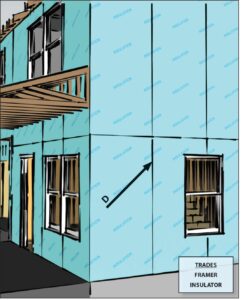What is a HERS Score and Why is it Important in Updated Building Codes?
The HERS index score, or Home Energy Rating System score, is a measure of a home’s energy efficiency. It is calculated on a scale of 0 to 100, with 100…
How to assess the safety or potential toxicity of foam insulation panels?
You can assess the safety / toxicity profile of any manufactured product by reading the SDS (Safety Data Sheet) provided by the manufacturer. You should be able to find the…
Pros and Cons of Continuous Insulation (CI)
Continuous insulation is a building design practice where a continuous layer of insulation material is applied around the exterior of a building’s envelope, often in conjunction with other insulation methods.…
Achieving Net-Zero Energy in Older Houses: A Step-by-Step Retrofit Guide
As the world faces the pressing challenges of climate change and energy sustainability, the concept of net-zero energy has gained increasing importance. Net-zero energy, also known as zero-energy buildings or…
A Home or Business Energy Assessment Can Save You Money
Some of the top benefits of getting an energy audit for your home or business in Massachusetts are: – You can dramatically reduce your energy bills by identifying and implementing…
Using Recycled Insulation Can Reduce Your Carbon Footprint
Insulation is one of the most important aspects of building design and construction, as it affects the comfort, health, and energy efficiency of the occupants. However, not all insulation materials…
How Below Grade Polyiso Insulation Can Help You Achieve Net Zero Energy or Passive House Standards
Net Zero / Passive House Building Standards for Lowest Energy Use & Carbon Emissions If you are looking for a way to reduce your energy consumption and greenhouse gas emissions,…
Pros and Cons of Polyiso vs EPS vs XPS for Continuous Insulation
Continuous insulation (CI) is a layer of insulation that covers the entire building envelope without any thermal bridges, such as studs, joists, or rafters. CI reduces heat loss and improves…
Reclaimed and Recycled Insulation Materials Have Economic and Environmental Benefits
Did you know 90% of US homes are under-insulated and that heating and cooling of all buildings comprises 29% of the total US energy budget? If all US homes were…









